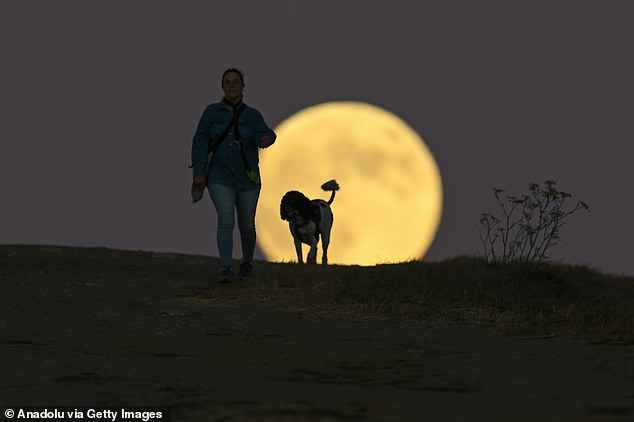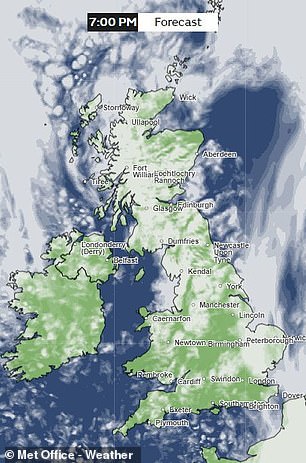Why you CAN’T miss the best supermoon of the year as Hunter Moon lights up the sky today – here it is visible and when you can see the specular display
It may not be Halloween yet, but stargazers can still enjoy an unmissable spooky treat tonight.
Tonight the spectacular Hunter’s Moon will light up the skies around the world.
Experts say this supermoon will be the most impressive full moon of the year, as our lunar satellite will appear up to 14 percent larger and 30 percent brighter.
A supermoon is formed when the moon approaches the closest distance to Earth in its 27-day orbit.
At a distance of just 357,173 km, the Hunter’s Moon will be the closest supermoon to Earth this year.
The best time to see this stunning display is as the moon rises over the northwestern horizon this evening from 6:02 PM BST.
And with the Met Office predicting dry weather and patches of clear skies, there should be plenty of good chances to see this year’s best full moon.
It may not be Halloween yet, but stargazers can still enjoy an unmissable spooky treat tonight. Tonight the spectacular Hunter’s Moon will light up the skies around the world
Anna Gammon-Ross, senior planetarium astronomer at the Royal Observatory Greenwich, told MailOnline: ‘A supermoon is the result of a Full Moon which occurs when the moon is near the closest point to Earth in its orbit.
‘This may happen because the moon orbits the Earth on an elliptical orbit, rather than a circular orbit.’
Although “supermoon” is not a scientifically recognized term, it is generally defined as any full moon that occurs when the moon is within 90 percent of its closest point to Earth, or perigee.
“Since a supermoon means the moon is a little closer to us, it will appear a little bigger in the sky,” says Ms Gammon-Ross.
Normally the moon orbits at a distance of 384,400 km from Earth.
During tonight’s event, however, the moon will be nearly 17,000 miles closer than normal.
The Hunter’s Moon takes its name from the traditional naming system for full moons first introduced in the Old Farmer’s Almanac.
Ms Gammon-Ross says: ‘This system gives each full moon a name that corresponds to characteristics or activities of each specific month. The Hunter’s moon indicates a particularly good time of year for hunting.’

A supermoon is formed when the moon approaches its closest point to Earth. During tonight’s supermoon, the moon will be nearly 17,000 miles closer than normal. Pictured: A plane flies over San Francisco for the Hunter’s Supermoon
According to the Old Farmer’s Almanac, October was considered the best time for hunting, as deer and other animals took to the recently harvested fields in search of food.
The moon reached its point of maximum proximity to Earth in the early hours of this morning at 12:46 am and will be at its fullest at 12:26 pm this afternoon – although the moon will not be visible from Britain at this time .
However, the moon will remain full for the next three days, so there is still plenty of time to get a good look at this lunar treat.
To get a clearer view, it’s best to find a spot away from street lights with an unobstructed view of the horizon.
Give your eyes time to adjust to the darkness and make sure you don’t ruin your night vision by using your phone.
Although special equipment is not necessary, you can see more of the moon’s surface with binoculars or a small telescope.
For the most spectacular views, it’s also best to view the moon shortly after it rises or before it sets.

It is best to see the full moon while it is lower on the horizon. This makes the moon appear larger and can give a yellow or orange glow under the right conditions. Pictured: The Hunter Moon rose last night over San Mateo, California
While the moon is close to the horizon, it will appear even larger due to a psychological effect called the ‘moon illusion’.
When the moon rises or sets, it can also take on a beautiful orange or red glow thanks to the sun’s light filtering through the Earth’s atmosphere.
Gases in our atmosphere scatter light in the blue regions of the visible spectrum.
This makes the sky appear blue and gives more red light to the moon.
Tonight the moon rises at 5:51 PM BST, shortly before the sun sets at 6:02 PM BST.
This means it’s best to try to view the moon as close to sunset as possible to catch it while it’s even lower on the horizon.
Alternatively, early birds have a good chance of seeing the supermoon on the morning of October 18 before the moon sets at 08:55 BST.
Fortunately, the Met Office predicts that there will be good weather for stargazing in much of the country.


The Met Office forecasts that there will be clear skies (left) and limited rainfall (right) from 7pm this evening. This means that there must be sufficient opportunities to see the supermoon well
Andrea Bishop, spokesperson for the Met Office, told MailOnline: ‘Almost all of Britain has a good chance of clear skies this evening.
‘Western Scotland will be a little cloudier, which may prevent extended views of the moon here, but otherwise cloud amounts will be patchy and should not restrict views of the supermoon or comet for extended periods.’
Patchy cloud will develop over England and Wales at 6:00 PM BST, with frequent breaks in clear skies.
Meanwhile, rain is not forecast for the west coast of Scotland and a few small areas of northern England until the early evening.
The moon will remain full for three days, so you can try again until the morning of October 19.
If you happen to miss the Hunter’s Moon this year, don’t worry because there will be another super moon.
The Hunter’s Moon is the third of four supermoons in 2024, with the next forecast for November 15 with the full Beaver Moon.
